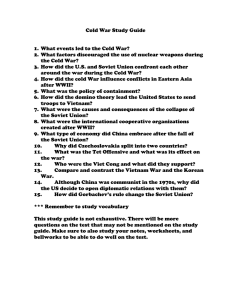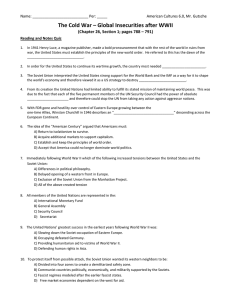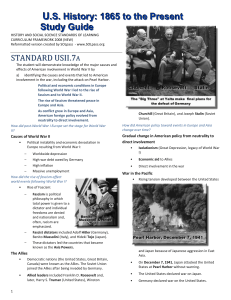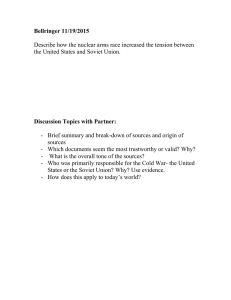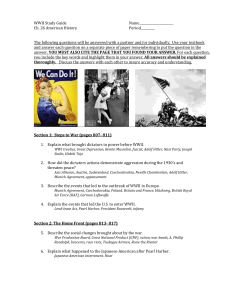African American Response to Jim Crow
advertisement
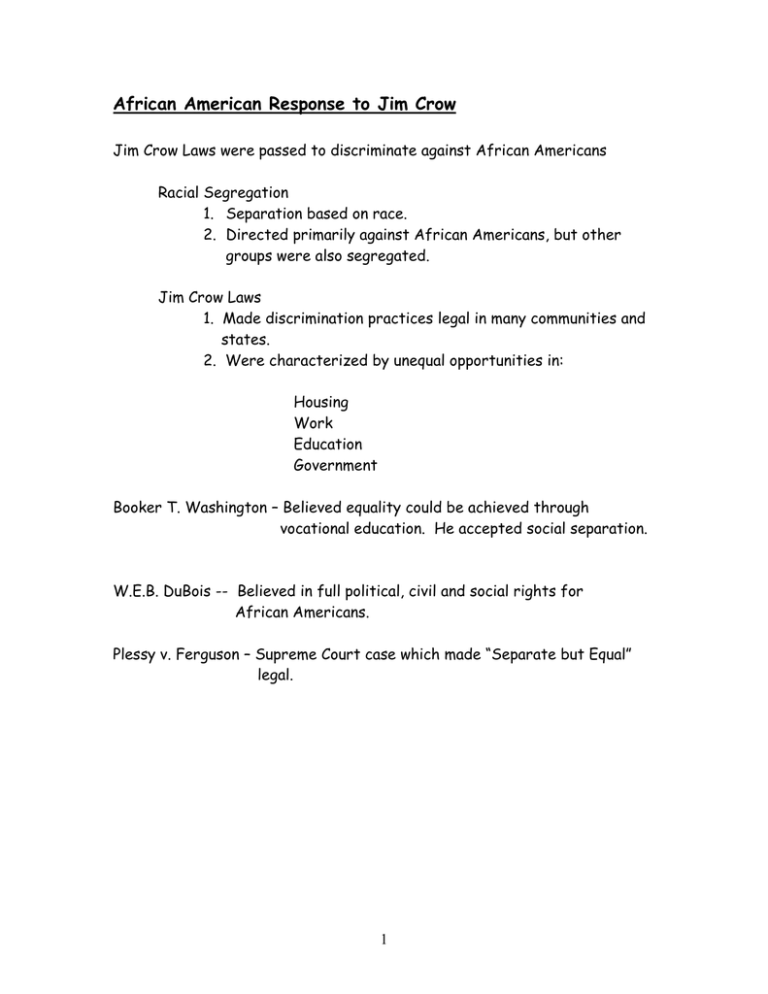
African American Response to Jim Crow Jim Crow Laws were passed to discriminate against African Americans Racial Segregation 1. Separation based on race. 2. Directed primarily against African Americans, but other groups were also segregated. Jim Crow Laws 1. Made discrimination practices legal in many communities and states. 2. Were characterized by unequal opportunities in: Housing Work Education Government Booker T. Washington – Believed equality could be achieved through vocational education. He accepted social separation. W.E.B. DuBois -- Believed in full political, civil and social rights for African Americans. Plessy v. Ferguson – Supreme Court case which made “Separate but Equal” legal. 1 The Great Plains Physical features and climate of the Great Plains Flatlands that rise gradually from east to west Land eroded by wind and water Low rainfalls Frequent dust storms KNOW that because of new technologies, people saw the Great Plains not as a “Treeless Wasteland” but as a vast area to be settled. Inventions and adaptations Barbed wire Steel plows Dry farming Sod houses Beef cattle raising Wheat farming Windmills Railroads Reasons for westward expansion Opportunities for land ownership Technological advances, including the Transcontinental Railroad Possibility of wealth created by the discovery of gold and silver Adventure A new beginning for former slaves 2 Interaction and conflict between different cultural groups Indian policies and wars US government wanted to place American Indians onto reservations. The Indians didn ‘t want to go to reservations. The Battle of Little Bighorn. The Sioux Indians killed General Custer and all his troops. Also known as Custer’s Last Stand. Chief Joseph. Chief of the Nez Perce Tribe. His tribe tried to make it to Canada rather than be sent to a reservation. The US Calvary stopped them 40 miles from the border. Chief Joseph made a famous speech…… “……..Hear me my chiefs! I am tired. My heart is sick and sad. From where the sun now stands, I will fight no more forever.” Discrimination against immigrants Many immigrant groups faced discrimination. Two examples of this are the Chinese and the Irish. Both of these groups worked on the Transcontinental Railroad. 3 Industrialization & Growth of American Cities Post Civil War changes in farm and city life Mechanization (the reaper) had reduced farm labor needs and increased production. Industrial development in cities created increased labor needs. Industrialization provided access to consumer goods. (mail order) Reasons for increased immigration Hope for better opportunities Religious freedom Escape from oppressive governments Adventure Transportation of resources Moving natural resources (copper & lead) to eastern factories. Moving iron ore deposits to steel mills (Pittsburgh) Transporting finished products to national markets. Examples of manufacturing areas Textile industry………………..New England Automobile Industry………..Detroit Steel Industry…………………..Pittsburgh Meatpacking………………………..Chicago Examples of big business Railroads Oil Steel 4 Reasons for rise and prosperity of big business National markets created by transportation advances Captains of Industry o John D. Rockefeller – Oil o Andrew Carnegie – Steel o Henry Ford – Automobiles Advertising Lower-cost production Inventions that contributed to great change and industrial growth Lighting and mechanical uses of electricity – Thomas Edison Telephone – Alexander Graham Bell Factors resulting in growth of industry Access to raw materials and energy Availability of work force Inventions Financial Resources Challenges faced by cities Tenements and ghettos Political Corruption (political machines) Rapid industrialization and urbanization led to overcrowded immigrant neighborhoods and tenements Efforts to solve immigration problems Settlement houses, such as Hull House founded by Jane Addams Political machines that gained power by attending to the needs of new immigrants (jobs, housing) POLITICAL MACHINES HAD BOTH POSITIVE & NEGATIVE EFFECTS 5 Negative effects of industrialization Child labor Low wages, long hours Unsafe working conditions Progressive Movement workplace reforms Improved safety conditions Reduced work hours Restrictions placed on child labor Rise of organized labor Formation of Unions – Growth of American Federation of Labor (AFL) Strikes – Aftermath of the Homestead Strike 6 Spanish American War Reasons for the Spanish American War Protection of American business interests in Cuba. American support of Cuban rebels to gain independence from Spain. Rising tension as a result of the sinking of the USS Maine in Havana Harbor Exaggerated news reports of events –Yellow Journalism Results of the Spanish American War The United States emerged as a world power. Cuba gained independence from Spain. The United States gained possession of the following: 1. The Philippines 2. Guam 3. Puerto Rico 7 WWI Reasons for US involvement in WWI Inability to remain neutral German submarine warfare – sinking of the Lusitania US economic and political ties to Great Britain Great Britain France Russia Serbia Belgium United States (in 1917) ALLIES CENTRAL POWERS Germany Austria-Hungary Bulgaria Ottoman Empire US leadership as the war ended At the end of WWI, President Woodrow Wilson prepared a peace plan, The 14 points, that called for the formation of The League of Nations, a peace keeping organization. The US decided not to join the League of Nations because politicians were worried about being caught up in future European wars. 8 Early 20th Century Transportations changes Use of the assembly line by Henry Ford made automobiles more affordable for Americans. Transportation improved because of more people having automobiles. Results of improved transportation brought on by affordable automobiles Greater mobility Creation of jobs – to make cars, sell them, service them, to build roads etc. Growth of transportation related industries – road construction, oil, steel, automobile Movement to suburban areas. Communication changes Increased availability of telephones. Development of the radio (Marconi – wireless signals) Development of the broadcast industry (Sarnoff) Development of movies Ways electrification changed American Life Labor saving products, washing machines, electric stoves, water pumps. Electric lighting Entertainment – radio Improved communications TECHNOLOGY EXTENDED PROGRESS INTO ALL AREAS OF AMERICAN LIFE, INCLUDING NEGLECTED RURAL AREAS. 9 THE GREAT MIGRATION The Great Migration north started when great numbers of African Americans moved north in search of better lives. Jobs for African Americans in the South were scarce and low paying. African Americans faced discrimination and violence in the South. African Americans moved to northern cities in search of better employment opportunities. African Americans also faced discrimination and violence in the north. Temperance Movement & Prohibition Made up of groups opposed to the making and consuming of alcoholic beverages. The groups supported the 18th amendment prohibiting the manufacture, sale, and transport of alcoholic beverages. Prohibition was imposed by a constitutional amendment that made it illegal to manufacture, transport or sell alcoholic beverages. Results of Prohibition Speakeasies were created as places for people to drink alcoholic beverages. Bootleggers smuggled illegal alcohol and promoted organized crime. Women’s Suffrage The women’s suffrage movement was not only to attain voting rights for women, but also to attain increased educational opportunities for women. Women gained the right to vote with the 19th amendment to the Constitution. Susan B. Anthony worked for women’s suffrage. 10 Cultural climate of the 1920s & 1930s Review the following people from the people to know section. 1. 2. 3. 4. 5. Georgia O’Keefe F. Scott Fitzgerald John Steinbeck Aaron Copland George Gershwin Harlem Renaissance African American artists, writers and musicians based in Harlem revealed the freshness and variety of African American cultures. Review the following people from the people to know section. 1. 2. 3. 4. 5. Jacob Lawrence Langston Hughes Duke Ellington Louis Armstrong Bessie Smith Know that the popularity of these artists spread to all of American Society. 11 The Great Depression Causes of the Great Depression People overspeculated on stocks, using borrowed money that they could not repay when stock prices crashed. The federal reserve failed to prevent the collapse of the banking system. High tariffs strangled international trade. Impact on Americans A large number of banks and businesses failed One fourth of workers were without jobs Large numbers of people were hungry and homeless Farmers’ income fell to low levels Major features of the New Deal Social Security Federal work programs Environmental improvement programs Farm assistance programs Increased rights for labor THE NEW DEAL WAS FRANKLIN D. ROOSEVELTS PLAN 12 World War II The causes of WWII: There are two main causes of WWII they are; 1. The political instability and economic devastation in Europe resulting from World War I. 2. The rise of Fascism You need to understand the above two causes. Think of them this way. 1. The governments of countries in Europe were not strong. Since the governments were having problems, it was hard for life to get back to normal after WWI. Many countries were having money problems too. This was because so much stuff and so many cities, towns and farms were hurt during WWI, the countries were having a hard time paying for everything to get fixed. I listed some examples below. A. Worldwide depression It was the 1930’s, the rest of the world was in a depression just like the United States. B. High war debt owed by Germany The other countries in Europe blamed Germany for the war. They made Germany pay for most of the damage that was caused by WWI. C. High Inflation This means that people had to pay a lot of money for the things they needed like food and clothes, even if they weren’t getting paid a lot of money. D. Massive Unemployment This means that many people were out of work. It also means that there really weren’t any jobs for these people to work in. 2. Fascism is a political philosophy in which total power is given to a dictator and individual freedoms are denied. Germany, Italy and Japan were fascist countries. 13 Change in the American Policy FIRST America believed in isolationism. That means the we wanted nothing to do with the problems other countries were having. We felt this way for two reasons. 1. The Great Depression was going on. We were having enough trouble taking care of ourselves. We didn’t want anyone else’s problems. 2. The legacy of World War I. This means that because we remembered how bad WWI was, we didn’t want to get involved in another war. THEN America was friends (another word for allies) with Great Britain. We wanted to help them, but didn’t want to actually be in the war. So we started giving Economic Aid to the Allies. FINALLY Direct involvement in the war. That means that finally, the US was fighting in WWII. That happened because Japan attacked Pearl Harbor on December 7, 1941. 14 War In The Pacific (How did Pearl Harbor happen?) 1. Rising tension developed between the United States and Japan because of Japanese aggression in East Asia. 2. On December 7, 1941, Japan attacked the United States at Pearl Harbor without warning. 3. The United States declared war on Japan. In other words…….. The United States and Japan were mad at each other. The United States said it was because Japan was being a bully to the other countries in East Asia. Japan said it was because it wasn’t any of the United States business what happened in East Asia. So, after awhile, Japan thought they could keep The United States out of the war by destroying the American fleet (navy ships) in the pacific. The ships were at Pearl Harbor, so Japan bombed Pearl Harbor. The United States was really mad that Japan bombed Pearl Harbor and said we weren’t in the war and Japan should have left us alone. We were so mad that we declared war on Japan. Basically, they hit us, and we hit them back. 15 Who was in World War II The Allies The Axis Great Britain Canada Untied States Russia (both the US and Russia joined the Allies in 1941) Germany Japan Italy The leaders: ALLIES Great Britain………………….Winston Churchill Russia……………………………….Joseph Stalin United States…………………Franklin D. Roosevelt (when Roosevelt died in 1945, Harry S. Truman became President) THE AXIS Germany…………………………..Adolf Hitler Italy…………………………………Benito Mussolini Japan……………………………….Hideki Tojo 16 Major Events and Turning Points of World War II In Europe 1. Germany invaded Poland. This started the war in Europe. The Soviet Union also invaded Poland and the Baltic nations. 2. Germany invaded France, capturing Paris. 3. Germany bombed London and the Battle of Britain began. 4. The United States gave Britain war supplies and old naval warships in return for military bases in Bermuda and the Caribbean. 5. Germany invaded the Soviet Union. 6. After Japan bombed Pearl Harbor, Germany declared war on the United States. The United States then declared war on Germany. 7. The Soviet Union defeated Germany at Stalingrad, marking the turning point of the war in Eastern Europe. 8. American and Allied troops landed in Normandy, France on D-Day to begin the liberation of Western Europe. 17 Major Events and Turning Points of World War II In the Pacific 1. Japan bombed Pearl Harbor. 2. The United States declared war on Japan 3. The United States won the Battle of Midway against Japan. Marking the turning point of the war in the Pacific. 4. The United States dropped two atomic bombs on Japan. Hiroshima and Nagasaki were the two cities the atomic bombs were dropped on. The bombings forced Japan to surrender and ended World War II. The Holocaust The Holocaust was the attempted extermination of all Jews in Europe by the Nazis in World War II which led to the mass murder of 6 million Jews. Some of the ways the Nazis tried to do this. They threatened Jewish people. Then they boycotted Jewish stores. Then they segregated Jewish people. Then they imprisoned and killed Jews and other groups the Nazis wanted to get rid of. They sent them to concentration camps where many were gassed and others were worked to death. After the war, Allied forces liberated the concentration camps. 18 Some Effects of World War II American involvement in World War II ended the Great Depression. Factories and workers were needed to produce goods to win the war. Thousands of American women took jobs in defense plants during the war. A symbol used to encourage this was Rosie the Riveter. American at home supported the war by conserving and rationing resources. The need for workers temporarily broke down some racial barriers. But, there was still discrimination. While many Japanese Americans served in the armed forces, others were treated with distrust and prejudice, and many were forced into interment camps. Post War Stuff The United States Role as a World Leader: Much of Europe was in ruins after World War II. Soviet forces occupied most of Eastern and Central Europe and the eastern part of Germany. The United States felt it was in it’s best interest to rebuild Europe and prevent political and economic instability. In others words….The US wanted to rebuild Europe to keep another war from starting. The United Nations was formed near the end of World War II to create a body for the nations of the world to try to prevent future global wars. 19 Rebuilding Efforts The United States instituted George C. Marshall’s plan to rebuild Europe. It was called the Marshall Plan. It provided for massive financial aid to rebuild European economies and prevent the spread of communism. Germany was divided into East and West Germany. o West Germany became democratic and went back to selfgovernment after a few years of American, British and French occupation. o East Germany remained under the control of the Soviet Union and did not take on democratic institutions. Following its defeat, Japan was occupied by American forces. o Japan soon had a democratic form of government, started selfgovernment, and became a strong ally of the United States. Prosperity With rationing of consumer goods over, business converted (changed) from production of war materials to consumer goods. Americans purchased goods on credit The workforce shifted back to men, and most women returned to family responsibilities. Labor unions merged (joined together) and became more powerful. Workers got new benefits and higher salaries. As economic prosperity continued and technology boomed, the next generation of women re-entered the labor force in large numbers. 20 THE COLD WAR The United States and the Soviet Union emerged from World War II as world powers. The two countries had lots of differences. They had always had lots of differences but, had been able to come together to defeat an enemy they both had….Hitler. Now that WWII was over the tension between the two countries became very bad. The Cold War started. It was the main thing that formed foreign affairs for forty years. Origins of the Cold War 1. Differences in goals and ideologies between the United States and the Soviet Union. Goals & ideologies means what the countries wanted, and what they believed. The United States was democratic and capitalist The Soviet Union was dictatorial and communist 2. The Soviet Union’s domination over Eastern European countries. 3. American policy of containment this was to stop the spread of communism. 4. North Atlantic Treaty Organization ~ NATO ~ was made up of the United States, Canada and some Western European countries. It was formed to protect from Soviet aggression. 5. Warsaw Pact was made up of The Soviet Union and other Eastern European countries. The Warsaw Pact was an answer to NATO. 21 Major Conflicts in the Post-World War II Era 1. South Korea and the United States resisted Chinese and North Korean aggression. The conflict ended in a stalemate. 2. The Cuban Missile Crisis occurred when the Soviet Union placed missiles in Cuba. The Soviets removed the missiles in response to a US blockade 3. The United States intervened to stop the spread of communism into South Vietnam. Americans were divided over whether the United States should be involved militarily in Vietnam. The conflict ended in a cease fire agreement in which US troops withdrew. Collapse of Communism and New Challenges Breakup of the Soviet Union into independent countries. Destruction of the Berlin Wall. By the late 1980’s The Soviet Union was starting to lose it’s grip on Eastern Europe. Many of the Eastern European countries demanded their independence. Communism was being replaced with a free market system. On November 9-11, 1989 The Berlin Wall came tumbling down as hundreds of thousands of people cheered and the world watched. Challenges After The Cold War Role of US military intervention. Environmental challenges. Global issues, including trade, jobs, diseases. 22 Changing Patterns in US Society After WWII & The Cold War Strong economy….healthy job market, increased productivity, increased demand for American products. Greater investment in education. The Baby Boom which led to changing demographics. Interstate highway system. Evolving role of women (expected to play supporting role in the family, but increasingly working outside the home.) Role of Eleanor Roosevelt in expanding women’s rights. African Americans’ aspirations for equal opportunities. Changes in make-up of immigrants after 1965….more Hispanics and Asians. G.I. Bill of Rights gave educational, housing, and employment benefits to WWII veterans. Truman desegregated the armed forces. Civil Rights legislation led to increased educational, economic, and political opportunities for women and minorities. 23 Civil Rights Some Effects of Segregation Separated educational facilities and resources for white and African American students. Separated public facilities like restrooms, drinking, fountains, restaurants. Social isolation of races. Civil Rights Movement 1. Opposition to Plessy v. Ferguson which upheld “Separate but Equal” 2. Brown v. Board of Education required the desegregation of schools. 3. Martin Luther King, Jr. practiced passive resistance against segregated facilities. Most famous speech…..I have a dream…… 4. Rosa Parks --- Montgomery Bus Boycott 5. Organized protests like freedom rides, sit-ins, marches. 6. Expansion of the National Association for the Advancement of Colored People NAACP 7. Civil Rights Act of 1964 Banned discrimination based on race, sex or national origin. The Civil Rights Act benefited all minorities. 8. Voting Rights Act of 1965 Banned voting discrimination, outlawed literacy tests. 24 Changing Role of Women Workplace disadvantages Discrimination in hiring practices against women. Lower wages for women than for men doing the same job. Improved conditions National Organization for Women NOW Federal legislation to force colleges to give women equal athletic opportunities. The Equal Rights Amendment, despite its failure, and a focus on equal opportunity employment created a wider range of options and advancement for women in business and public service. 25 Peacetime Technologies Industries benefiting from new technologies Airline industry……Jets Automobile industry and interstate highway system. Entertainment and news media industry. Exploration of space. Computer industry. Satellite system……telecommunications….pagers, cell phones, TV. Internet Impact of New Technologies on American Life Increased domestic and international travel for business and pleasure. Greater access to news and other information. Cheaper and more convenient means of communication. Greater access to heating and air conditioning. Decreased regional variation, resulting from nationwide access to entertainment and information provided by national television and radio programming, Internet services, computer games. 26

